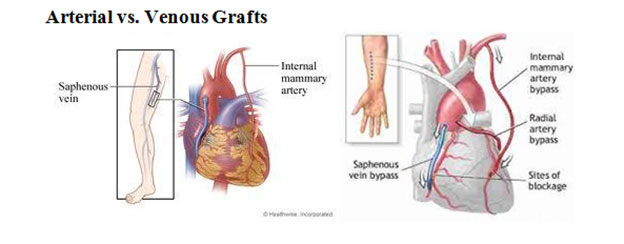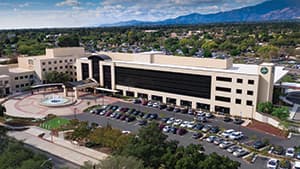
Coronary Artery Bypass Graft or CABG

Diagnostic tests for coronary artery disease
- Electrocardiogram (ECG or EKG): A minimally invasive test that is used to reflect underlying heart conditions by measuring the electrical activity of the heart.
- Stress Test: An electrocardiographic test of heart function before, during and after a controlled period of increasingly strenuous exercise.
- Echocardiography: The use of ultrasound to examine the structure and functioning of the heart for abnormalities and heart disease.
Coronary Angiography: An X-ray image of blood vessels after they are filled with contrast material. This is the primary method for evaluating the presence of coronary artery disease and the exact location and severity of the coronary artery disease.
Benefits of coronary artery bypass graft surgery (CABG)
Coronary artery bypass surgery will improve blood flow to the heart. CABG surgery will relieve chest pain, fatigue, and other symptoms of coronary artery disease. The grafting procedure that surgeons perform results in an increase in blood flow, decreasing the probability of a heart attack. The procedure can also enable a patient to manage risk factors of their coronary artery disease and prevent future blockages.
- Bleeding during or after the surgery
- Blood clots that can cause heart attack, stroke, or lung problems
- Infection at the incision site
- Pneumonia
- Breathing problems
- Pancreatitis
- Kidney failure
- Abnormal heart rhythms
- Failure of the graft
- Death
There may be other risks depending on your specific medical condition. Be sure to discuss any concerns with your doctor before the procedure.
Preparing for coronary artery bypass graft (CABG) surgery
- If you smoke, quit as soon as possible prior to the surgery.
- Notify your doctors of all the medications that you take, including over-the-counter medications.
- Pack light for your hospital stay. Bring necessities like a toothbrush and glasses if you wear them. Do not bring valuables or jewelry.
- DO NOT eat or drink anything after midnight before the CABG surgery, including water.
The day of your coronary artery bypass graft (CABG) surgery
Once at the facility, a nurse will start an IV line in your arm or your hand which will provide access for fluids and medications required during the heart surgery. If needed, hair will be removed from your chest and any other incision sites for a sterile field. Anesthesia will be given before the surgery starts and this will keep you free from any pain during the procedure. Anesthesia will put you into a deep sleep state, and a tube will be placed in your mouth down your throat to take over your breathing during the surgery.
How a coronary artery bypass graft (CABG) surgery is performed
Preparing the graft for bypass

The blood vessels most commonly used for the bypass are the saphenous vein from the leg and the internal mammary artery located on the left side of the chest wall. Another option is the radial artery located in the arm.
The heart is cooled with iced salt water. A preservative solution is then injected into the blood vessels of the heart. This process minimizes damage caused by reduced blood flow during surgery.
“Off-pump CABG” is a coronary artery bypass graft surgery performed without the use of a heart-lung machine. Once your doctor has opened the chest, he or she will stabilize the area around the artery to be bypassed with a special instrument. The rest of the heart will continue to function and pump blood through the body. The heart-lung bypass machine and the person who runs it may be kept on stand-by just in case the procedure needs to be completed on bypass.
The grafting portion of the surgery can now begin by attaching a grafted blood vessel beginning at the aorta to beyond the narrowing or blockage, also known as an aortocoronary bypass. Once the graft is prepared it will be sewn into place. You may have heard the words single bypass, double bypass, triple bypass or quadruple bypass surgeries. These refer to the number of arteries that are bypassed, and it does not necessarily indicate how severe the heart disease is. Once the graft has been attached, blood will start flowing in this new pathway, bypassing the blockage.
Before the chest is closed, the doctor will closely examine the grafts to make sure they are working. The breastbone is then wired together, and the chest incision is closed. Chest tubes are left in place to allow drainage of any remaining blood from the space around the heart and are usually taken out of the body within a couple of days.
After the coronary artery bypass graft surgery.
- The tube that is helping you breathe will be in place and need to stay in place until your vital signs are stable enough to remove it.
- Expect nurses to ask you questions that require you to nod your head, indicating a “Yes or No” answer.
- After the removal of the tube, expect to have a mask or small prongs in your nose so you can continue to receive supplemental oxygen.
- You will be required to do breathing exercises every hour in a device, called an incentive spirometer and encouraged to do as much physical activity as possible to prevent pneumonia, blood clots, and other complications.
- An IV will be present throughout your hospital stay to provide medications and fluids.
- An arterial line will be present in your wrist or upper arm to monitor accurate blood pressure or other pressures in your heart.
- Chest tubes will be present to drain out fluid in your chest from the surgery.
- A urinary catheter will be present to drain out urine.
- Temporary pacing wires, from your chest to your heart, will be present for regulation of the heart beat if needed.
- If needed, an intra-aortic balloon pump will be present to take over some of the heart’s pumping function.
This is necessary if the heart needs to relax and recover from the CABG surgery, and you will be sedated until this is removed.
- Pain will be managed by medications through your IV or in pill form.
- It is important to notify the nurse if the pain medication is not helping and to be honest in expressing how much pain you feel.
Going Home
Cardiac Rehabilitation
Heart Center Quick Links
